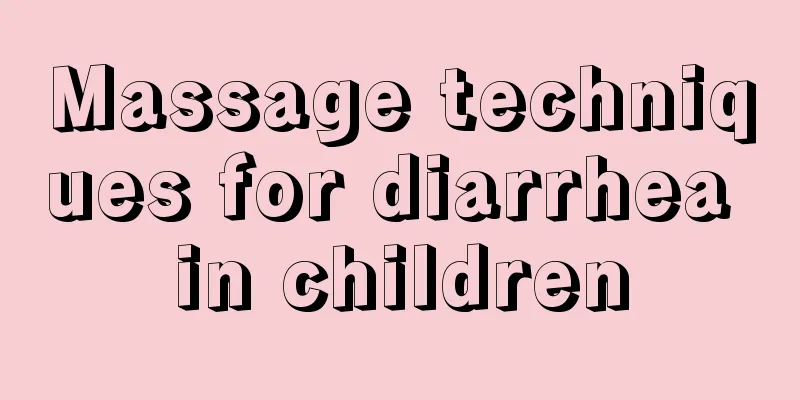What should I do if my child has a stuffy nose? These methods are very useful

|
If a child has a stuffy nose, it may be that he has a cold or the baby has caught a chill, so at this time, you must take good warming measures and do a good job of hygiene to avoid infection. You can use some medications under the doctor's advice and closely observe the condition. If there is no improvement, you need to see a doctor. In addition, you can also use some small folk remedies to help treat it. 1. What to do if a child has a stuffy nose If you find that your baby has symptoms of pediatric nasal congestion, that is, nasal congestion and runny nose that are difficult to control, then it is best for parents to take the baby to the hospital for treatment first. After the doctor has confirmed the condition and found out the cause, follow the doctor's instructions to take medication. In addition, experts pointed out that if the baby has severe nasal congestion that affects breathing, 0.5% ephedrine furacillin drops can be used cautiously under the guidance of a doctor, which usually takes effect within a few minutes. However, ephedrine has side effects on babies and is not suitable for excessive or long-term use, so as to avoid causing atrophic rhinitis and affecting the olfactory sensitivity of the nose. If your baby has a lot of purulent nasal discharge, you can ask the doctor to do replacement therapy to clear out the purulent secretions in the sinuses. However, medication for babies must be given under the guidance of a doctor to avoid causing harm to the baby's health. Finally, in daily life, parents must remember to keep their newborns warm, especially before and after sleeping and bathing at night, to avoid colds. 2. Folk remedies for treating nasal congestion in children Children's nose and nasal cavity are relatively short. Newborns have almost no inferior nasal meatus and no nasal hair. The nasal mucosa is weak and rich in blood vessels, so it is easy to be infected, causing congestion and swelling of the nasal mucosa and nasal congestion. Symptoms of nasal congestion in newborns include difficulty in sucking, irritability and crying, shortness of breath or breathing, and snoring while sleeping. If a child has a stuffy nose, you should first check whether there is any mucus or other foreign matter blocking the nasal cavity. If there is any blockage, it must be cleared immediately. After eliminating the nasal congestion caused by foreign body blockage, the following methods can be used to treat it: 1. Dry the scallion, wash and mash it, squeeze out the juice, and put 2 to 3 drops into the nose each time, 2 to 3 times a day. 2. For babies with nasal congestion and runny nose, use 3 grams each of Angelica dahurica and Perilla leaf, grind them into fine powder, put them in a bottle, and let the baby smell it twice a day, each time for 30 to 60 seconds. Or use moxa sticks to moxibustion the Baihui point (the intersection of the midline of the top of the head and the line connecting the two ear tips) for 5 to 10 minutes each time, twice a day. 3. For those with nasal congestion and yellow turbid mucus, use 3 grams each of mint and cicada shell, add 120 ml of water, boil and extract 60 ml, take it in 3 times, 1 dose per day. Vasoconstrictive nasal drops such as ephedrine, dibijing, and nasal tonifier can easily cause atrophy of the nasal mucosa if used for a long time, so they should be used with caution. Do not use adult nasal drops for newborns. 3. How to prevent nasal congestion in children There are several types of nasal congestion in children: nasal congestion due to cold, nasal congestion due to foreign body obstruction, and nasal congestion due to allergic rhinitis. Let’s take a look at these three ways to prevent nasal congestion in children. Prevention and treatment of cold and nasal congestion: 1. About half a month after the baby is born, start to supplement cod liver oil in moderation; start to add complementary foods at 4 months and supplement vitamin A. You can feed some liver puree, carrot puree, and vegetable puree to enhance the defense ability of the respiratory tract. 2. When using air conditioning, the temperature difference between indoor and outdoor should not be too large. The baby's room should be around 28 to 30 degrees Celsius. 3. Place a warm, wet towel on the baby's nose for hot compress (not too hot), twice a day, each time for about 15 minutes. |
<<: Be careful when taking medicine for diarrhea in children, don’t take it like this!
>>: Preventing children from getting sick can improve their immunity
Recommend
The later a boy develops, the taller he is
It is mostly not true that the later a boy develo...
Child cross-eyed
Cross-eyed is what people often call crossed eyes...
What should I do if I get frostbite and red blood streaks when I am a child?
People will have red blood streaks in all seasons...
What can children with precocious puberty eat?
Nowadays, most children with precocious puberty a...
What to do if your 52-day-old baby has a stuffy nose?
It is normal for newborn babies to catch a cold, ...
What are the symptoms of intestinal spasms in children?
Intestinal diseases in children are one of the ki...
Should babies be bathed every day?
Many parents bathe their newborn babies every day...
After the beginning of autumn, keep an eye on your baby and beware of five diseases
The beginning of autumn has just passed, and alth...
What are the precautions for injecting meningococcal a+c vaccine?
Generally speaking, in order to better resist dis...
Recovery period and treatment of bronchopneumonia in infants
Parents of children will find that after the baby...
What is the cause of the pain in one of the child's ears?
Many children will experience ear pain in their l...
How to relieve baby's anal redness
When the baby has frequent diarrhea, it is easy t...
What foods can children choose to eat to replenish kidney deficiency
The best time to nourish the kidney is in winter,...
What are some tips on how to teach your baby to walk?
When babies learn to walk, parents feel very happ...
What should children eat to improve their physical fitness?
Some children are born with good physical constit...









